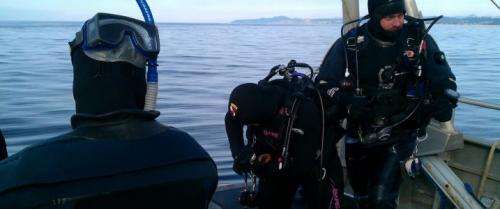Study of marine life near Newport finds no red flags for toxicity

(Phys.org) —Oregon State University scientists have examined a variety of coastal marine species near Newport, Ore., for concentrations of heavy metals and organic pollutants and found only trace amounts with no bioaccumulation of significant concern.
Their report is being presented May 19 to the City of Newport, which commissioned the study. It is available online at: www.thecityofnewport.net/
Newport city officials were concerned that effluent from a Georgia-Pacific containerboard plant outfall pipe, located some 4,000 feet off Nye Beach, may be exposing some marine life to contaminants. A 2010 study by CH2M-Hill looked for heavy metals in the surrounding water and sediments and found little with which to be concerned. Their study did not investigate marine organisms, however.
"There was some concern that metals and organic pollutants may be bioaccumulating in nearby marine life," said Sarah Henkel, a marine ecologist at OSU's Hatfield Marine Science Center and primary investigator on the study. "We tested for 137 different chemicals and only detected 38 of them – none at levels that remotely approach concern for humans."
The City of Newport had asked the OSU researchers to look at a variety of species, including flatfish (speckled sand dab), crustaceans (Dungeness crab and Crangon shrimp), and mollusks (mussels and olive snails) because they could bioaccumulate metals and organic pollutants at different rates. The researchers collected a variety of samples in 2012 near the G-P outfall, as well as at sites north of Yaquina Head and south of Yaquina Bay. In fall of 2013, they also collected and analyzed rock scallops.
The organisms were analyzed for trace metals including copper and lead, polychlorinated biphenyls (PCBs) and congeners, polybrominated diphenyl ethers (PBDEs), which are used in flame-retardant materials, and other potentially carcinogenic compounds. They also were analyzed for organic-based compounds, which are commonly derived from pesticides.
Not a single organism was found with a bioaccumulation of metals or organic pollutants that approached levels of concern for humans established by the U.S. Food and Drug Administration, the researchers reported.
"The system is pretty darn clean," said Scott Heppell, a biologist with the OSU Department of Fisheries and Wildlife and co-primary investigator on the study. "I was certainly interested personally going into the study because my family goes crabbing in some of the places we sampled. If we had found anything, we would have had to come up with a new place. But we found nothing approaching the level of intervention for humans and that's reassuring."
The OSU researchers did find one area of potential future concern – trace levels of arsenic in mussels at sites both north and south of Yaquina Bay. The arsenic levels were still below the FDA level of concern for human consumption (86 parts per million), Heppell said, but in some cases exceeded the established level of concern for impacts to the mussels themselves, which is 3.6 ppm. Some of the samples analyzed by the researchers reached 5.0 ppm.
"It is still 15 times lower than the threshold for human concern, but there is potential for damage to the mussels themselves," Heppell said. "It is also worth noting because the arsenic was in virtually all of the mussel samples we collected on beaches from Seal Rock to north of Yaquina Head. There is no way to draw a link to the G-P outfall.
"But because it was so common, it may be a good idea to study mussel populations up and down the entire coast to see what arsenic levels are at beyond our study area."
Arsenic is often used in pressure-treated lumber and wood preservatives, the researchers noted.
Among other findings:
- The researchers found three derivatives of dichlorodiphenyltrichloroethane, or DDT, a pesticide that has been banned for 40 years. Although it was detected at very small amounts, "the fact that it is still present in organisms four decades later shows why it was banned," Henkel said.
- No significant bioaccumulation could be attributed to the G-P outfall. In fact, fish, crabs and shrimp collected from subtidal sites away from the outfall often had higher concentrations of metals than those adjacent to the pipe, though still at levels safe for human consumption.
- Two DDT derivatives (2,4'-DDE and 4,4'-DDD) were found in a single crab sample. Another, hexochloro-benzene, was detected in just two crab samples – at concentrations some 10,000 times less than the toxicity level listed as potentially affecting the crabs themselves.
"It is worth noting that the instrumentation today is so sensitive it can detect trace amounts of compounds at concentrations not possible just a few years ago," Heppell said.
The OSU researchers praised the City of Newport for seeking data that potentially could have been damaging, yet was important to know.
"This is one of those reports that, thankfully, turns out to be rather boring," Henkel said.
Provided by Oregon State University


















